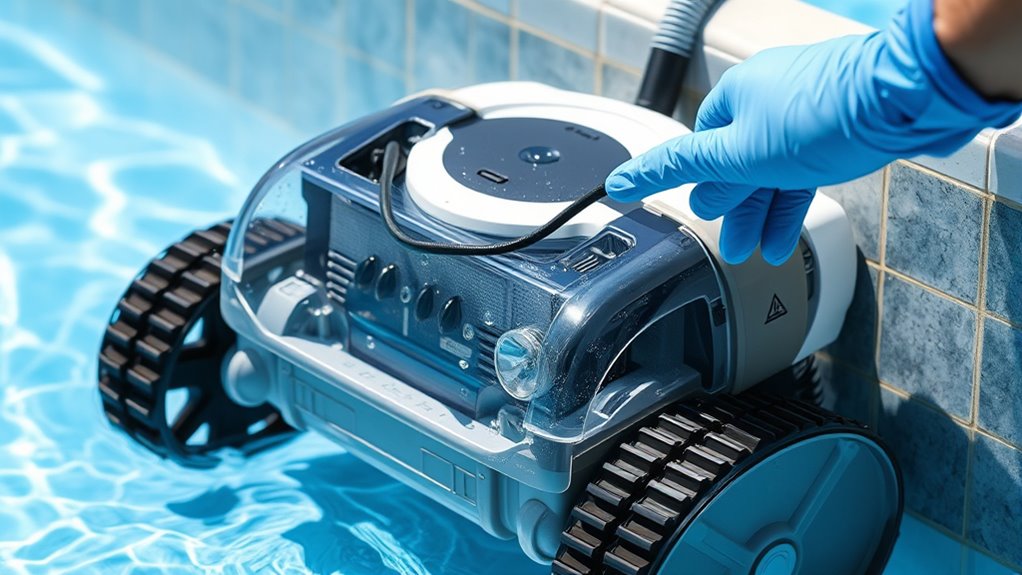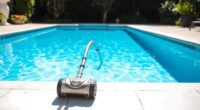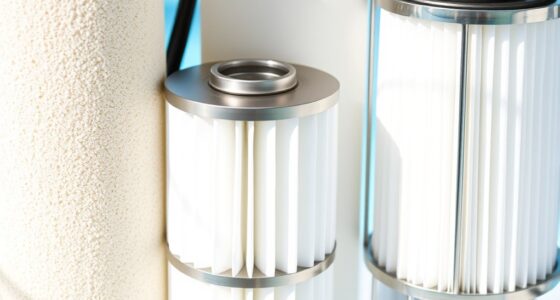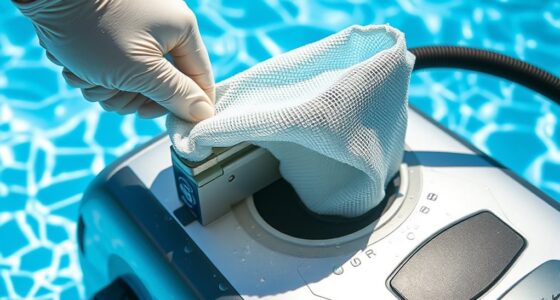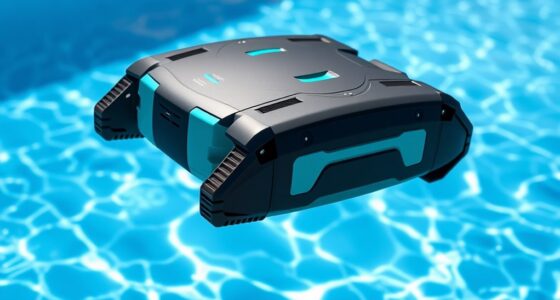If your robotic pool cleaner faces issues, start by checking the power supply, connections, and charging contacts to guarantee it’s powered and charging correctly. Clean sensors, brushes, and filters to improve navigation and cleaning performance. Inspect for leaks, water damage, or blockages that could cause malfunctions. Confirm firmware and app updates are installed and minimize wireless interference for better connectivity. For persistent problems, exploring detailed troubleshooting tips below can help you get your cleaner back in action.
Key Takeaways
- Check power supply, cords, and outlet functionality to resolve power and charging issues.
- Clean sensors, brushes, and filters regularly to improve navigation and cleaning performance.
- Inspect gaskets, seals, and drainage channels for leaks or blockages, replacing parts as needed.
- Update firmware and app software promptly to fix bugs and enhance device communication.
- Clear debris and remove obstacles to prevent the cleaner from getting stuck or stopping mid-cycle.
The Cleaner Is Not Powering On

If your robotic pool cleaner isn’t powering on, the first step is to check the power source. Make certain the power supply is plugged in securely and that the outlet functions correctly by testing it with another device. Sometimes, circuit troubleshooting reveals a tripped breaker or blown fuse stopping power flow. Reset any tripped circuit breakers or replace blown fuses as needed. Inspect the power cord for damage or loose connections that could interrupt power delivery. If your cleaner has a power adapter, verify it’s working properly. By confirming the circuit troubleshooting process and verifying the power supply, you can quickly identify if the issue lies with the power source or if further inspection is necessary. Additionally, inspecting for electrical safety issues can help prevent potential hazards. It’s also beneficial to consult the manufacturer’s guidelines on electrical components to ensure all parts are functioning correctly. Regular maintenance and checking for corrosion or wear on connections can prolong the lifespan of your cleaner and prevent future issues. Moreover, ensuring the battery health is good can also impact the device’s power status. Performing a diagnostic test as recommended by the manufacturer can further help identify underlying problems.
The Device Is Not Moving or Stuck in One Spot
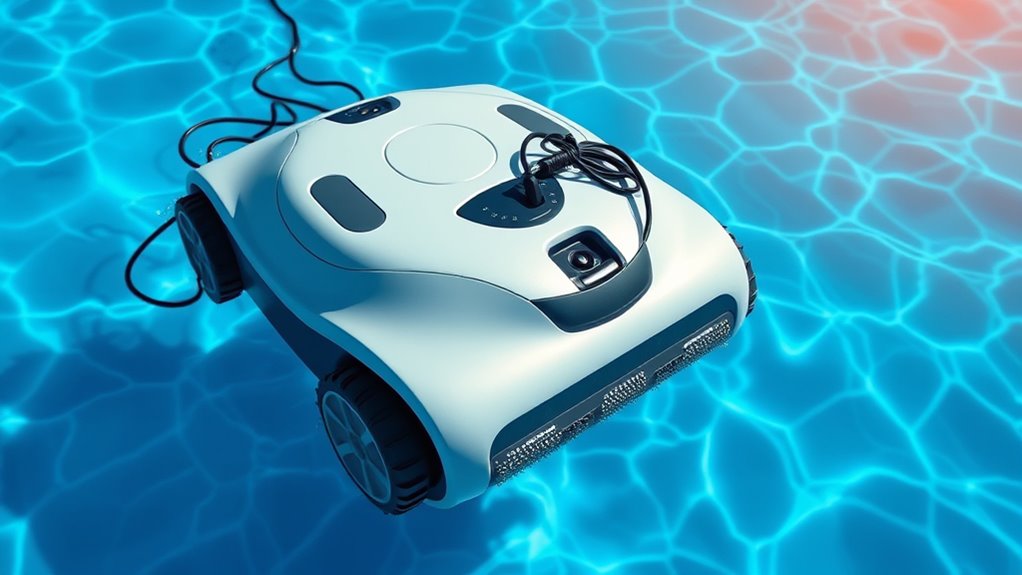
When your robotic pool cleaner remains stuck in one spot or isn’t moving as it should, the issue often lies in the device’s navigation or obstacle detection systems. Navigation errors can cause the cleaner to lose track of its position, making it get stuck or stop moving altogether. Obstacle detection sensors might be failing or misaligned, causing the device to hesitate or avoid certain areas. Check if the sensors are clean and free of debris, as dirt or algae can impair their function. Ensure the cleaner’s path is clear of obstacles like toys or pool accessories that could trigger detection errors. Regularly inspecting and calibrating sensor alignment can help maintain accurate obstacle detection and improve movement. Proper maintenance and clear pathways usually help your cleaner move smoothly across the pool. Additionally, understanding GMC tuning principles can provide insights into optimizing electronic systems that might be relevant for advanced robotic cleaners. For example, adjusting the navigation algorithms can improve the device’s ability to adapt to complex pool shapes. Also, keeping the power supply and connections in good condition is important to prevent operational issues. Maintaining optimal sleep and mental health through regular routines can also positively impact your ability to troubleshoot and care for your device effectively.
Poor Cleaning Performance or Missed Areas

A robotic pool cleaner that’s not performing well or missing spots often points to issues with its cleaning pattern, brush operation, or filter. If the cleaning brush isn’t spinning properly or is clogged with debris buildup, it can’t scrub surfaces effectively. Check the brush for obstructions and clean it thoroughly if needed. Debris buildup on the brushes or around the filter can also reduce suction and cleaning efficiency. Make sure the brushes are in good condition and rotate freely. Additionally, verify that the cleaner’s cleaning pattern isn’t restricted by obstacles or tangled cords. Regularly inspect and clear debris from the brushes and filter to guarantee peak performance. Proper system operation can help prevent these issues from recurring and improve overall cleaning coverage. Monitoring operating hours can help identify if the cleaner is overworked or needs maintenance sooner. Consistently performing routine maintenance on the cleaner and its components is essential for optimal functioning. Ensuring that the water flow is adequate can also improve cleaning effectiveness and prevent missed areas. Addressing these issues will help your cleaner cover the entire pool surface more thoroughly.
The Cleaner Is Running but Not Charging Properly
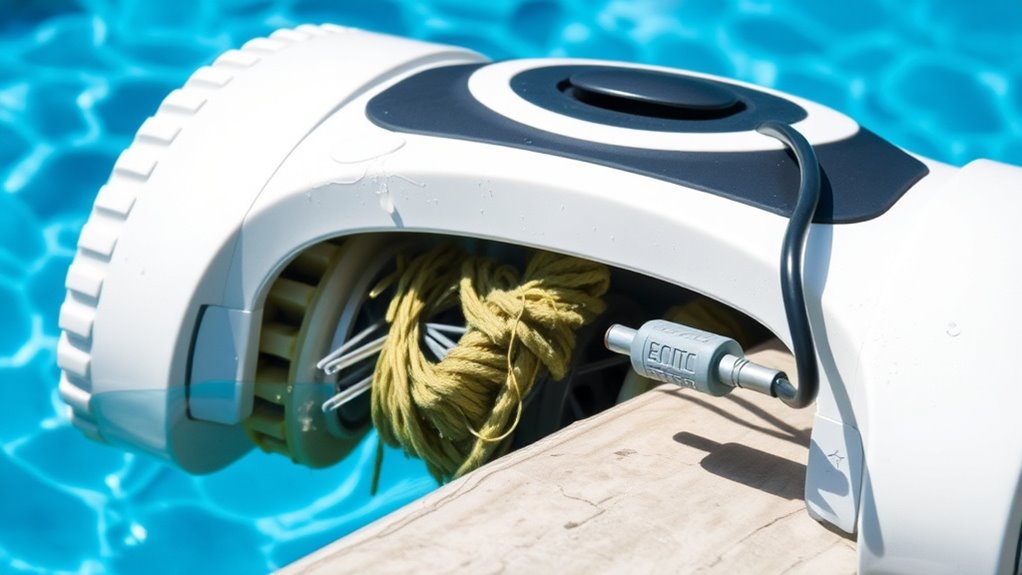
Even though your robotic pool cleaner runs smoothly, it might still struggle with charging properly. If it’s not holding a charge or stops before completing its cycle, check your battery maintenance. Over time, batteries can degrade, reducing their ability to hold a full charge. Inspect the charging station for dirt, corrosion, or damage that could interfere with power transfer. Ensure the cleaner is properly aligned with the station’s charging contacts. Sometimes, cleaning the contacts with a soft cloth can improve connectivity. Also, verify that the station’s power source is stable and functioning correctly. If issues persist, consider replacing the battery or repairing the charging station. Proper battery maintenance and keeping the charging station clean are key to ensuring your cleaner charges efficiently and operates reliably. Additionally, make sure the headphones are compatible with your device’s charging method and connections to avoid further issues. Regularly monitoring and maintaining the battery health can help prevent unexpected charging problems and extend the lifespan of your robotic cleaner. For optimal performance, consider the importance of charging station placement, ensuring it is in a dry, level area away from obstructions. Ensuring the power connection is secure and free from interruptions can also prevent charging issues.
Unusual Noises or Vibrations During Operation
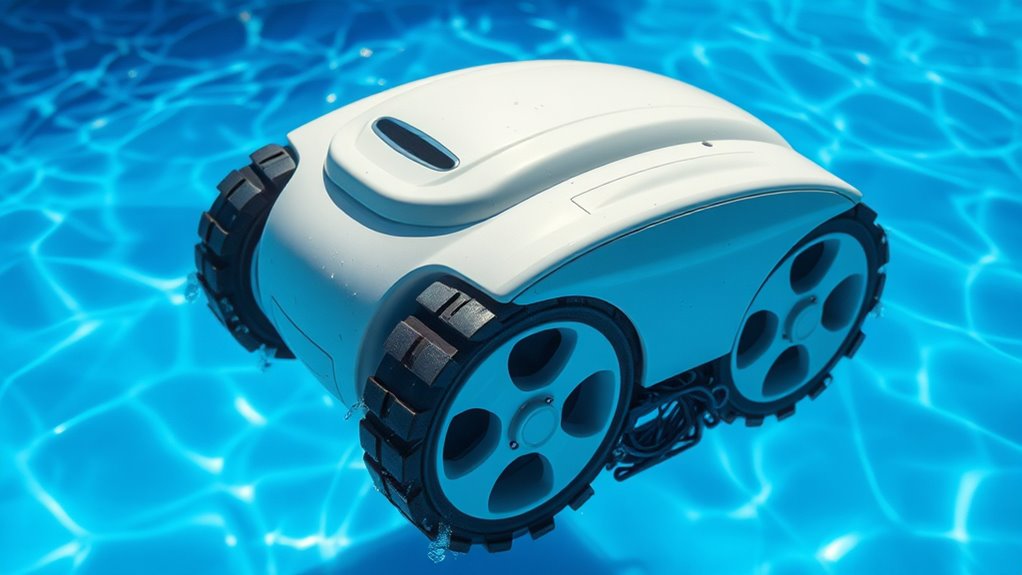
Unusual noises or vibrations during operation often indicate a mechanical issue or debris caught in the cleaner. If you hear grinding or rattling sounds, check the motor bearings, as they may be worn or damaged, causing excessive noise. Vibrations can also result from debris accumulation around the brushes or wheels, which disrupts smooth movement. Inspect the cleaner’s brushes, wheels, and internal components for tangled leaves, dirt, or other debris. Clearing out any obstructions and ensuring the motor bearings are well-lubricated can eliminate the noise and restore quiet operation. Regular maintenance, including cleaning the brushes and checking for debris buildup, helps prevent these issues. Addressing these problems promptly keeps your robotic pool cleaner running efficiently and extends its lifespan.
Water Leaks or Excessive Moisture Inside the Unit
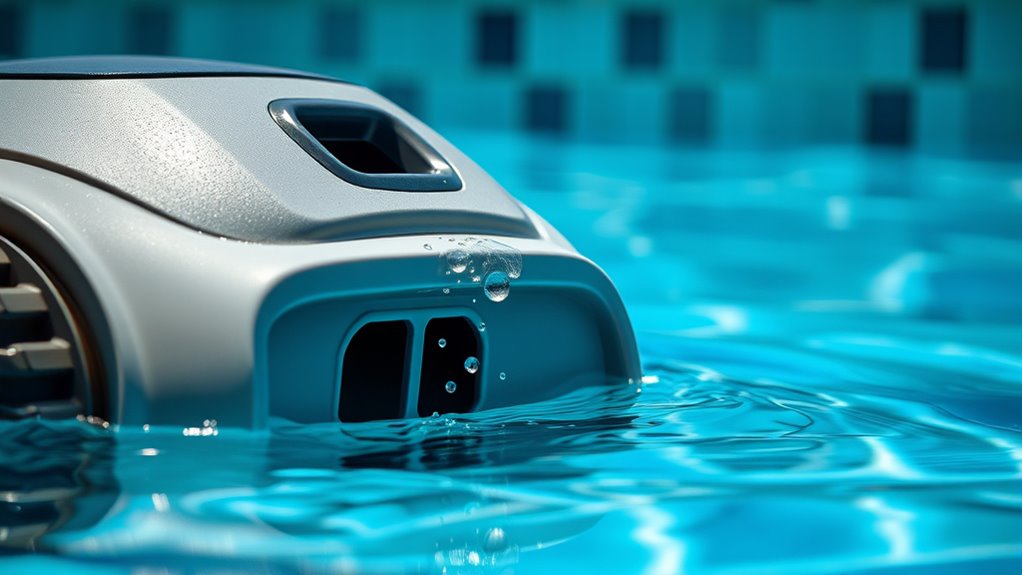
If you notice water leaking or moisture inside your cleaner, it’s often caused by seal integrity issues or drainage blockages. These problems can lead to water seeping into the unit and damaging internal components. Check the seals and drainage pathways to identify and fix the source of the leak quickly.
Seal Integrity Issues
Seal integrity issues are a common cause of water leaks or excessive moisture inside your robotic pool cleaner. If you notice leaks, check for seal leaks around the housing or internal compartments. These leaks often stem from gasket failures, which can occur over time due to wear, debris, or improper assembly. Inspect the gaskets carefully for cracks, tears, or deformities. Replacing faulty gaskets or resealing the affected areas can restore the unit’s water-tight integrity. Verify all seals are properly fitted and clean before reassembling. Regular maintenance and timely gasket replacements help prevent water infiltration that can damage internal components. Addressing seal leaks promptly keeps your cleaner functioning efficiently and extends its lifespan.
Drainage Blockages
Drainage blockages are a common cause of water leaks or excessive moisture inside your robotic pool cleaner. When the drainage system becomes clogged, it disrupts water flow, leading to leaks. To fix this, check the following:
- Inspect the drainage ports for debris or dirt buildup.
- Clear out any obstructions from the drainage channels.
- Ensure the water flow isn’t restricted by tangled hoses or filters.
- Verify that seals around drainage areas are intact and properly sealed.
Remote Control or App Connectivity Issues
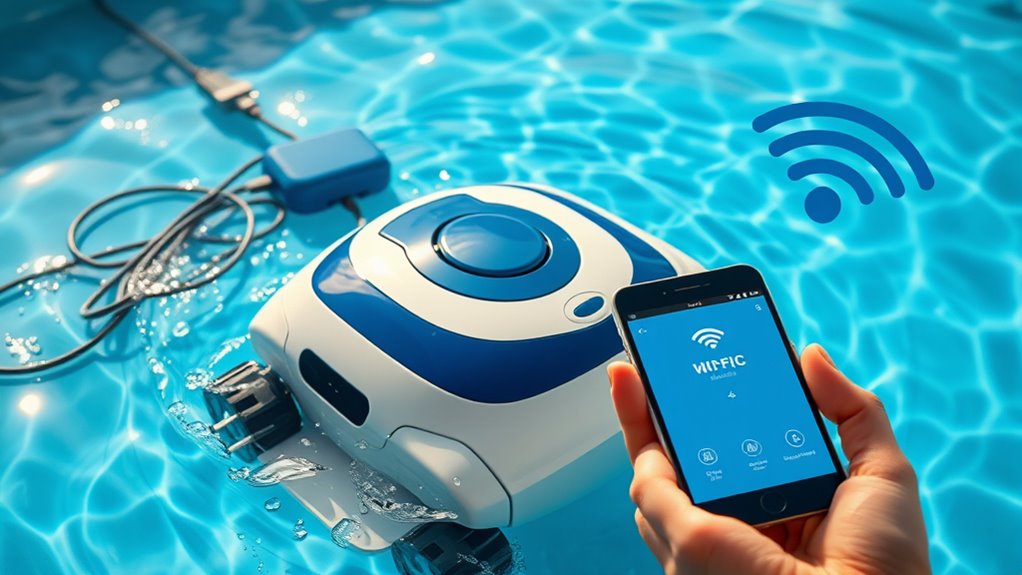
If you’re having trouble connecting your pool cleaner to the remote or app, start by checking your wireless connection stability. Make sure your device’s firmware and the app are up to date, as outdated software can cause issues. Updating these can often resolve connectivity problems quickly.
Wireless Connection Stability
Wireless connection issues with robotic pool cleaners can be frustrating, especially when you’re trying to control or monitor your device through an app or remote. To improve stability, consider these steps:
- Reduce wireless interference by keeping other electronics away from your router and cleaner.
- Move your Wi-Fi router closer to the pool area to strengthen the signal.
- Avoid obstacles like thick walls or metal objects that can cause signal dropout.
- Switch to a less congested Wi-Fi channel to minimize interference from nearby networks.
Addressing wireless interference and minimizing signal dropout can substantially enhance your connection stability. Regularly check your router’s settings and placement to ensure your cleaner maintains a strong, reliable link with your control device.
App and Firmware Updates
Regularly checking for app and firmware updates is essential to keep your robotic pool cleaner functioning smoothly. Software updates improve performance, fix bugs, and enhance features. Firmware troubleshooting can resolve connectivity issues and ensure your device communicates properly with your app. To stay current, open your app regularly and verify updates are available. If updates fail, restart your device and router, then try again. Keep your firmware up to date to avoid connectivity problems and guarantee optimal performance.
| Check Frequency | Action | Benefit |
|---|---|---|
| Weekly | Update app and firmware | Improved stability and features |
| When Issues Arise | Reinstall or update software | Resolves connectivity problems |
| Regularly | Monitor update notifications | Prevents firmware troubleshooting |
| After Firmware Release | Install latest updates | Ensures smooth operation |
The Cleaner Stops Mid-Cycle or Runs Irregularly
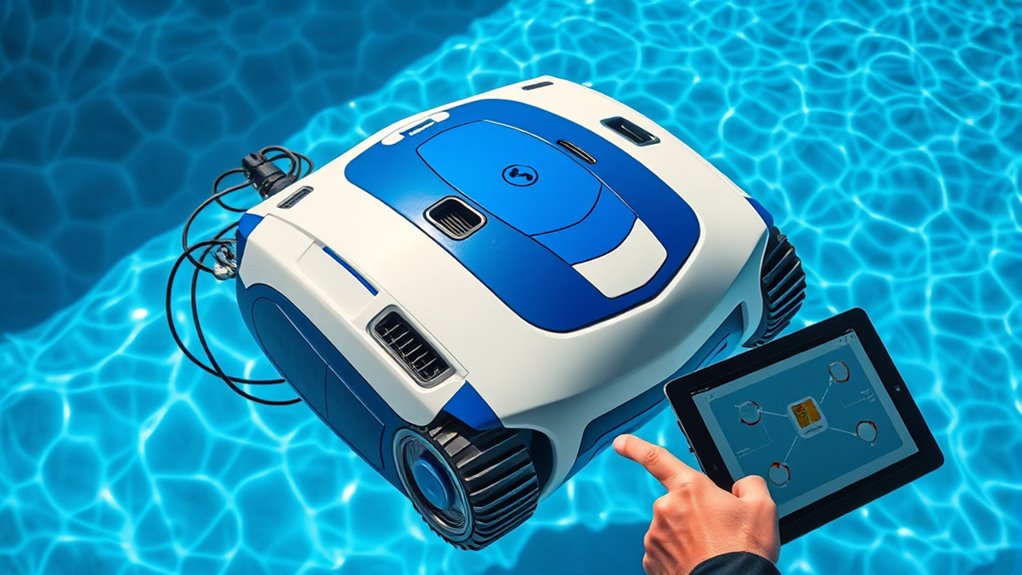
When your robotic pool cleaner stops mid-cycle or runs irregularly, it’s often a sign of an underlying issue that needs attention. Common causes include:
- Sensor malfunctions—dirt or damage can confuse the cleaner’s navigation.
- Battery degradation—over time, batteries lose capacity, causing inconsistent power.
- Obstructions—debris or tangled cords can interrupt movement.
- Firmware glitches—outdated software may cause operational errors.
Start by inspecting sensors for dirt or damage and clean them gently. Check the battery’s health and replace it if it’s old or failing. Clear any debris from the brushes and cords. Finally, update the firmware to ensure smooth operation. Addressing these issues should restore your cleaner’s regular cycle and performance.
Frequently Asked Questions
How Often Should I Perform Maintenance on My Robotic Pool Cleaner?
You should perform routine inspections on your robotic pool cleaner weekly to guarantee it’s working properly. Check for debris buildup and clean the brushes regularly. Additionally, replace the filter every few weeks or as needed, depending on usage and water quality. Regular maintenance keeps your cleaner running efficiently, extends its lifespan, and prevents future issues. By staying proactive, you’ll enjoy a cleaner pool with fewer interruptions and repairs.
Can Debris or Algae Damage the Cleaner’S Internal Components?
Think of your robotic pool cleaner as a vigilant guardian. Debris and algae can sneak past its defenses, causing damage to internal components. Regular filter maintenance guarantees debris doesn’t clog the system, while proper care safeguards the motor from strain. If you neglect these steps, you’re risking costly repairs. Keep your cleaner in top shape by cleaning filters often and checking for algae buildup, ensuring smooth operation and prolonged lifespan.
Is It Necessary to Recalibrate the Device After Repairs?
After repairs, you should definitely perform calibration procedures to guarantee your robotic pool cleaner functions correctly. Recalibration confirms that the device’s sensors and movement systems are aligned properly, preventing issues during operation. It’s a vital step to follow repair confirmation, as it assures your cleaner performs at its best. Skipping this step might lead to inefficient cleaning or further problems, so always recalibrate after servicing your device.
What Should I Do if the Cleaner’s Remote Control Stops Working?
Remember, a problem shared is a problem halved. If your cleaner’s remote control stops working, start with remote troubleshooting. Check the batteries and replace them if needed. Confirm there’s no signal interference from other electronic devices or obstacles blocking the signal. Keep your remote within the recommended range and try resetting it. These steps often solve remote issues quickly, helping your robotic pool cleaner get back to work seamlessly.
Are There Specific Storage Tips to Prolong the Cleaner’s Lifespan?
To prolong your robotic pool cleaner’s lifespan, proper storage maintenance is key. Store it in a cool, dry place away from direct sunlight and extreme temperatures. Always clean the filter and brushes before storage to prevent buildup. Detach the power supply and cord, then keep everything in a designated area. Regularly inspecting and maintaining your cleaner assures it stays in good condition, extending its lifespan and performance over time.
Conclusion
Remember, troubleshooting your robotic pool cleaner is like tending a delicate garden—you’ll nurture it back to health through patience and care. Each issue is a puzzle piece, revealing insights into the cleaner’s hidden heartbeat. By addressing problems step-by-step, you’ll restore its rhythm and keep your pool sparkling. With a little attention, your cleaner will dance gracefully across the water, transforming maintenance into a seamless, almost poetic, harmony of technology and trust.

